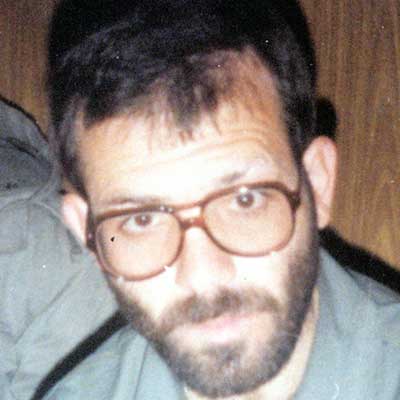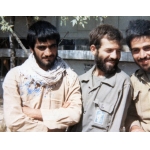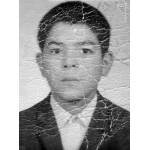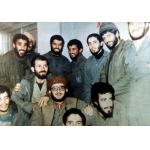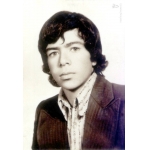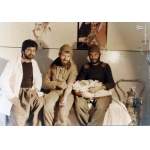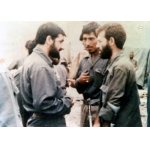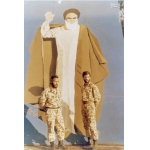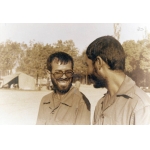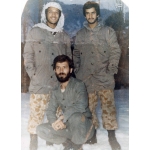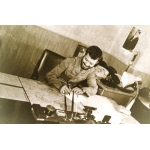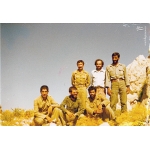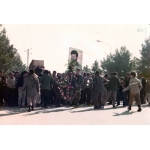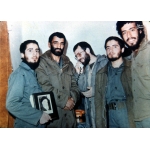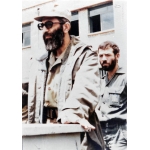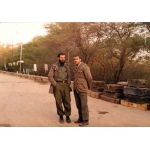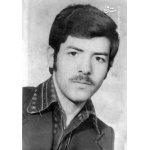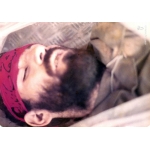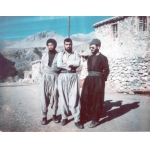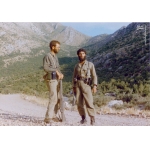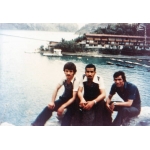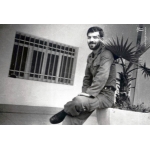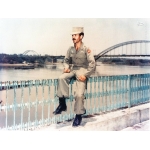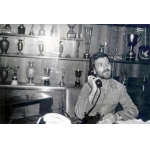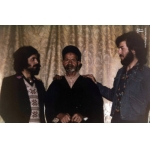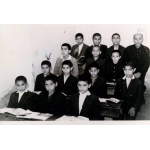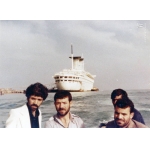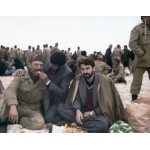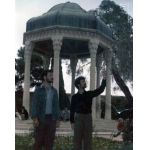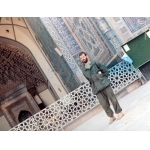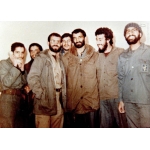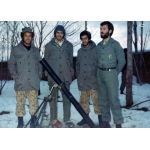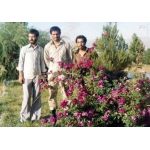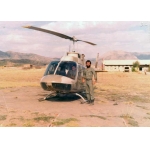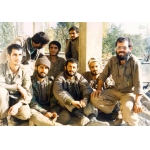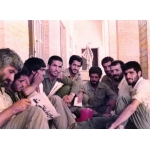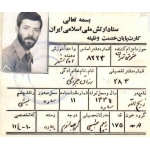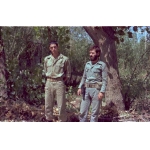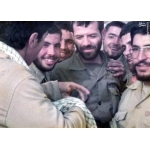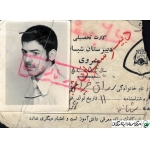Cheraghi, Reza
Kimia Ali Shahbaba
246 بازدید
Razaq Cheraghi (1957–1983), also known as Reza Cheraghi, was the commander of the 27th Prophet Muhammad Division and was martyred during Operation Valfajr 1 in the northern Fakkeh region.
Razaq Cheraghi was born in 1957 in the village of Setaq, Saveh. His father initially chose the name Abdul Razaq for him, but due to a registration error, his name was recorded incorrectly. Dissatisfied with this, his father decided to call him Reza. He completed his primary education at Sheikh al-Iraqin Bayat School in Khaniabad, Tehran. Afterward, he worked at his brother’s, Safiullah, shoe shop near the Globandak Crossroads during the day. At nights he would attend classes Marvi Night High School on Nasser Khosrow Street, where he eventually graduated with a diploma in science. During his teenage years, he had three close friends, one of whom was Seyed Mohammad Reza Dastwareh.[1]
In 1977, he joined the military. After completing his training, he was dispatched to the 92nd Armored Division of Khuzestan, where he became an adjudicator for Captain Hasan Aqarebparast’s relatives. In the fall of 1978, he fled the garrison with Aqarebparast’s relatives and moved to Tehran, where he and his friends participated in the marches leading up to the victory of the Islamic Revolution.
In the fall of 1979, Reza became a member of the Islamic Revolutionary Guards Corps. After receiving training in the 4th Tehran Corps Battalion, he was stationed at the Vali-e-Asr Garrison under Farjah al-Sharif to protect the area surrounding the U.S. Embassy (commonly known as the spy nest) for a month.
On January 27, 1979, he was dispatched to Kermanshah to carry out a mission in Ravansar.[2] Three months later, under the orders of Mohammad Boroujerdi, the commander of the 7th National District Corps, the 4th Tehran Corps Battalion was sent to Paveh to liberate Baingan. It was there that Reza met Ahmad Motevaselian, the commander of the Paveh Corps. Following that, along with Mohammad Reza Dastwareh, he joined Ahmad Motevaselian’s forces and took part in the liberation of Baingan in late May and the liberation of Marivan in June 1980. During his time in the war zones of Kurdistan, he was second-in-command of the Dezli Corps and was responsible for the Operational Axis of Tete for some time.
With the start of Iraq's imposed war against Iran, and with the consent of Ahmad Motevaselian, Reza, along with Hassan Zamani and Mohammad Reza Dastwareh, moved from Marivan to the Sarpol-e Zahab–Gilan-e Gharb axis, where they remained for about three months.[3]
He served as the battalion commander during Operation Mohammad Rasoulullah on December 2, 1982.[4] In the winter of 1981, alongside Ahmad Motevaselian, Mohammad Ebrahim Hemmat (commander of the Paveh District Corps), and Mahmoud Shahbazi (commander of the Hamedan Province Corps), Reza went to the southern front to form a combat brigade.[5] The 27th Mohammad Rasulullah Brigade was officially established on February 6, 1982, under Ahmad Motevaselian’s command. The brigade’s first two battalions, the Salman Farsi Battalion, commanded by Hossein Qajehi, and the Hamzeh Sayyid al-Shohada Battalion, commanded by Reza Cheraghi, were formed at the Dokuheh Garrison.
Reza commanded the battalion during Operation Fatah al-Mubin, which took place in the south on April 22, 1982. He fought alongside other key commanders, including Motevaselian and Hemmat.[6] After the operation, the 27th Brigade battalions, including the Hamzeh Sayyid al-Shohada Battalion, moved from Dokuheh Garrison to the Atomic Energy Camp in Darkhuyn in preparation for the preliminary phase of Operation Beit al-Moqaddas, alongside the other battalions of the 27th Brigade.[7]
Operation Beit al-Moqaddas began on May 30, 1982. Reza was wounded on the evening of May 10, 1982,[8] during the third phase of the operation. Due to the severity of his injuries, he was forced to rest for several months. During this time, the 27th Brigade was sent to Syria following the conclusion of Operation Beit al-Moqaddas and returned to Iran after the capture of Ahmad Motevaselian in Lebanon. Despite needing rest, Reza rejoined his colleagues in the brigade.[9]
Following the capture of Motevaselian, the command of the 27th Mohammad Rasulullah Brigade was handed over to Reza. He participated in the third phase of Operation Ramadan, which took place between July 13 and August 29, 1982. After the disappearance of Ismail Ghehremani, the brigade’s second-in-command, on August 25, 1982, Hemmat appointed Reza as the deputy commander of the brigade.[10] Despite his physical challenges, Reza took part in the fifth phase of Operation Ramadan on August 27, 1982, fighting alongside Hemmat on the front lines.[11]
After Operation Ramadan, and in line with decisions made by high-ranking commanders, the 27th Brigade’s Intelligence and Operations Forces moved to identify the Sumar operational area.[12] During Operation Muslim ibn Aqil (October 30–November 4, 1982, in Sumar), Mohammad Ebrahim Hemmat was appointed commander of Nasr Division and Zafar Operational Base, and Reza took command of the 27th Mohammad Rasoulullah Brigade.[13] Under his leadership, the brigade, comprising 13 battalions, delivered significant blows to Iraq’s Second Corps during the operation.[14]
Reza Cheraghi was later appointed commander of the Qadr Corps during the preliminary Valfajr operation (February 7–11, 1983), before handing over command to Ali Fazli, the commander of the 27th Division.[15] In March 1983, Reza married Masoumeh Dastvareh in a ceremony officiated by Ayatollah Mohammadi Gilani.[16]
Operation Valfajr 1 began on April 10, 1983, in northern Fakkeh, with Reza serving as the commander of the 27th Mohammad Rasulullah Division.[17] On the morning of April 15, he went to the front lines and, while fighting alongside his men to repel the 1st Mechanized Division of the 4th Iraqi Army, was martyred.[18]
His tomb is located in Section 24 of Tehran’s Behesht Zahra Cemetery,[19] and a highway in Tehran, located between Shahid Kazemi and Shahid Navab Safavi highways, is named Shahid Cheraghi in his honor.
[1] Babaei, Gol Ali, Raz An Setareh (The Secret of That Star) (Book 3 of the Twenty-Seven in 27 series), Tehran: Saeqeh, 2012, pp. 15-19.
[2] Ibid., pp. 19-22.
[3] Ibid., pp. 25-29.
[4] Ibid., pp. 31 and 32.
[5] Ibid., p. 35
[6] Ibid., pp. 37-40; Rashid, Mohsen, Atlas of the Iran-Iraq War, Tehran: Islamic Revolutionary Guard Corps, 2010, p. 48.
[7] Babaei, Gol Ali, The Secret of That Star, p. 50.
[8] Ibid., p. 61; Rashid, Mohsen, Atlas of the Iran-Iraq War, p. 49.
[9] Babaei, Gol Ali, The Secret of That Star, pp. 63-65.
[10] Ibid., pp. 64-69; Rashid, Mohsen, Atlas of the Iran-Iraq War, p. 68.
[11] Babaei, Gol Ali, The Secret of That Star, p. 71.
[12] Ibid., p. 85.
[13] Ibid., pp. 92 and 93; Rashid, Mohsen, Atlas of the Iran-Iraq War, p. 58.
[14] Babaei, Gol Ali, The Secret of That Star, p. 93.
[15] Ibid., p. 108; Rashid, Mohsen, Atlas of the Iran-Iraq War, p. 70.
[16] Abai, Gol Ali, The Secret of That Star, p. 113.
[17] Ibid., p. 121.
[18] Ibid., pp. 126-128.
[19] Ibid., p. 130


